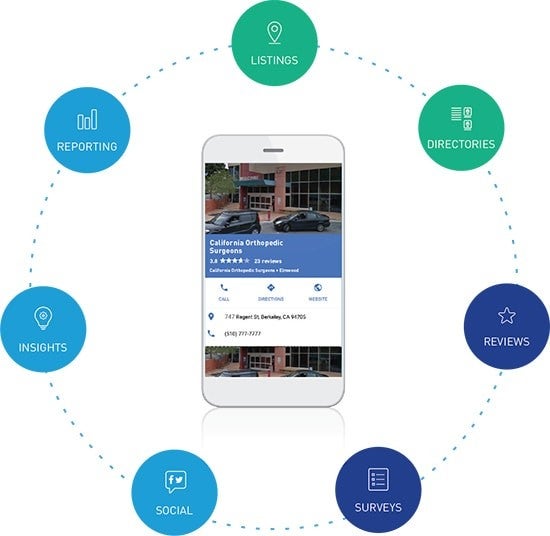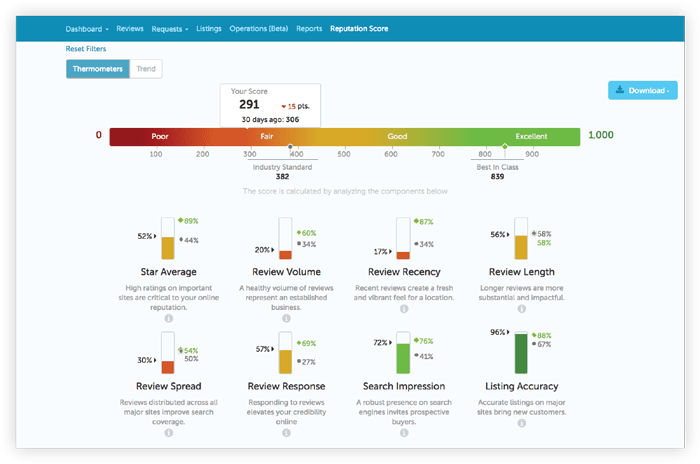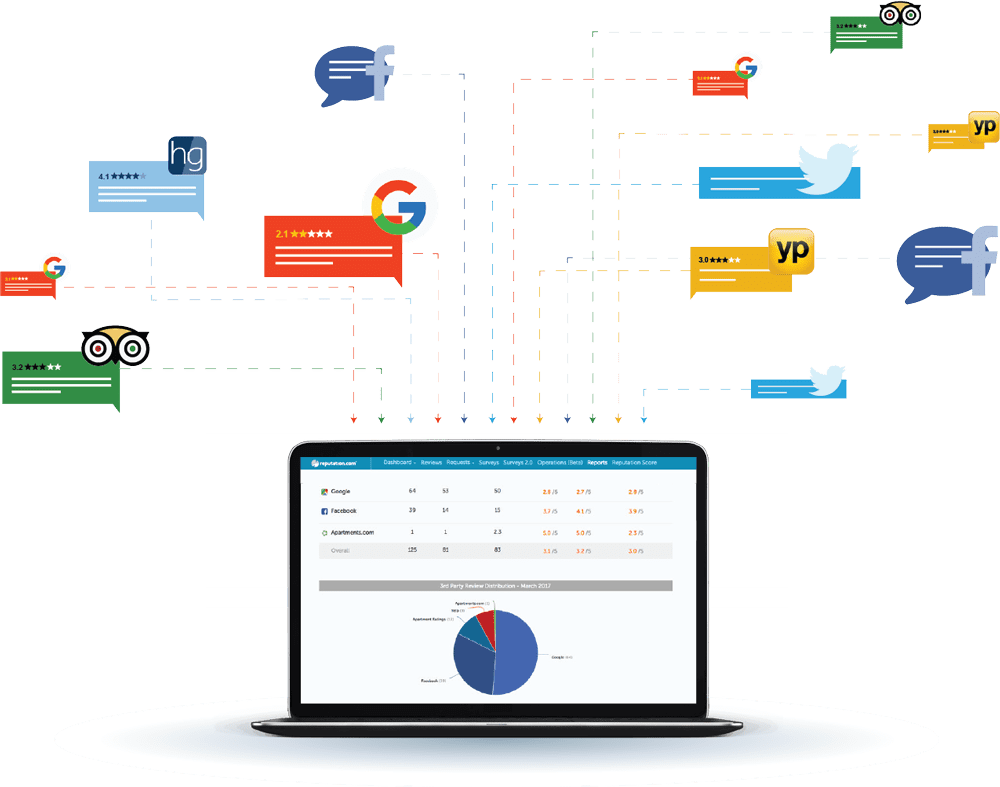The Case for Integrated Online Reputation Management for Healthcare
Reputation Staff Writer

Why an All-in-One Platform is Better Than Point Solutions
Scott Brinker’s 2018 Marketing Technology Landscape Supergraphic lists 6,829 individual products available to marketers — all of which promise to solve pressing problems related to generating revenue from marketing activities. Faced with choosing the best-in-breed, most valuable options from this long, every-growing, ever-changing list, marketers can quickly become overwhelmed.
And choosing solutions isn’t the end of the struggle. There are integration headaches, administration and maintenance overhead, along with potential support and consulting costs associated with maximizing investments.
Reduce risk, cost and complexity
In this world of proliferating technologies, many marketers are looking to reduce risk, cost and complexity by deploying platforms that combine the functionalities of various point solutions. Online reputation management (ORM) is one area in which such consolidation is possible, thanks to comprehensive platforms such as Reputation.com.
What you will learn:
In this paper, we will deconstruct the platform vs. point solution debate. You’ll learn how unifying the various aspects of ORM — namely, online reviews, business listings, surveys, social media management, ticketing, operational insights, analytics and reporting — can reduce the risk, cost and complexity of your technology stack and help you optimize the patient experience.
Healthcare Reputation Management Is a Human Endeavor
The real goal of online healthcare reputation management is to make it easy for consumers to find providers and see enough positive reviews to become a patient. A strong online presence is the result of carefully managed listings across major directories and an optimized website that ranks well for SEO.
Great reviews come from great patient experience. Those great reviews in turn increase your online visibility, helping more prospects become patients and brand advocates. This cycle drives review volume, search engine ranking and online reputation.
Online healthcare reputation management requires a well integrated platform that includes:

- Location listings management: Make it easy for people to find you and increase traffic to your locations.
- Website directory management: Improve local search by carefully managing your website content, locator and doctor pages.
- Review monitoring, requesting and responding: Collect candid feedback from online reviews so you can make improvements to patient experience.
- Analytics and reporting: Share valuable insights from patient feedback with key stakeholders, to inform and create accountability throughout the organization.
- Ticketing: Use triaging, categorization and remediation workflows to respond promptly to patient issues that surface in surveys, reviews and social conversations.
- Patient surveys: Get a pulse of patient sentiment before they complain online, and drill deeper to truly understand what issues need to be resolved sooner.
- Social engagement: Join — and lead — the conversation about your brand among local communities and use social channels for effective patient communication.
- Operational insights: Dig into patient experience data to uncover actionable insights that help improve operations.

The Risk of Multiple Point Solutions
The greatest process failures are often the result of loosely connected point solutions.
Does your technology stack have a blind side?
Technology disconnects and failures can be annoying in everyday life — in healthcare, they can be life-threatening. Even platforms that are not directly connected to EMR or patient record systems play a critical role in ensuring patients receive quality, compassionate care.

Say a patient visits a regional office, receives treatment and leaves.
While in the office, he fills out an online survey, but doesn’t raise a concern about the service received. Later, he leaves an independent review, gives your clinic a 2-star rating and makes scathing comments about the experience.
What went wrong? How can there be such disparity between the information shared directly with your team and the comments left on other sites?
Patients are often reluctant to share negative comments directly, for fear of it going “on-record” and creating friction with the doctor. Still, a negative patient experience can make its way into the public domain via social media and review sites, ndermining your reputation.
Even if you have a social monitoring platform and team in place to track sentiment and isolate negative comments, it’s rarely integrated with the customer feedback and reviews function. Information from these disparate data sources is frequently disconnected from operations, learning and development, or billing departments, where the underlying problem can be addressed. This disconnect prevents appropriate follow-up and problem resolution, impacting the quality of care you deliver — and your reputation.
In a 2017 study, cloud security provider Netskope found that 94% of all cloud applications used in business were not “enterprise ready.”

What about your data?
Beyond the risk of technology failures, there are other risks associated with piecing together multiple systems:
Data integrity
Maintaining point solutions necessitates continuous monitoring all data feeds to ensure nothing has changed on any of the systems — otherwise, you risk data corruption or loss.
Data security
Healthcare organizations are legally required to manage and protect patient data in very specific ways. Compromised patient data can have significant impact on the overall organization — and the brand. If your data is passing throughor residing on multiple third-party servers, you may be placing your organization at significant legal and financial risk.
Data sovereignty and ownership
Would you work with a vendor that claimed ownership of your data? Some vendors in the reputation management space contractually own any data they add to yours — including location data that your business depends on. If you end the vendor agreement, your data may be reverted back to the state it was in prior to engaging with that vendor.
Integration complexity
Integrating technology solutions from multiple vendors requires constant upkeep. Problems can arise when one vendor changes their data formats or algorithms. Will you be able to recognize when data and results are inaccurate — and how will you pinpoint and troubleshoot issues in a multi-vendor situation, where vendors deny fault and point the finger at the others?

The High Cost Of Multiple Point Solutions
Beyond software license or service fees, human capital and integration expenses can quickly drain project budgets and limit your ability to scale.

Is it possible to assemble a portfolio of hand-picked point products, stitch them together and spend less up-front and in monthly licensing, maintenance and administration fees than you would spend on an integrated platform? Yes, it’s possible . But it’s not likely. Hidden costs creep into the equation, especially when system- or API-level integration is required. And many point solutions overlap in some way, leading to duplication, inconsistencies and inefficient use of resources.
Hidden costs
Most cloud-based solutions have pricing models that are tied to the growth of your organization and subsequent technology needs. For example, as you add solutions, you also need API-level integration with enterprise apps, marketing platforms or industry-specific platforms. But these integrations frequently require you to move up to the most expensive enterprise tier of service.
Multiple niche systems also may require specialized resources to administer and operate. You’ll either need to recruit specialists or train existing staff — both of which take time and money, and delay your progress toward your marketing goals. Operator costs might not be considered at the onset, but they are real and cannot be avoided. With the current unemployment rate under 4%, hiring and retaining skilled technical resources is a constant challenge.

No Scale, No Sale
Costs accrue during failures and updates of your current solutions — but even more costs arise when you have to rip and replace a solution, either because your company has outgrown it or the vendor goes out of business.
Consider the average tenure of a point solution. If you have four or five solutions deployed, you probably anticipate swapping out one of them every 12-18 months. But if one of your vendors closes shop, they may leave you in the lurch, with unsupported legacy technology — or worse, a gap in your technology stack. Either scenario makes it difficult for new technologies to function at their best.
A platform that scales with your needs
An all-in-one platform is built to scale and grows along with your increasing ORM needs, so you don’t have to rip and replace anything. Each module is built to integrate seamlessly with the others; no expensive APIs or updates are necessary. And, it takes a solid and dedicated research and development team to create a full platform so that provider is likely well-funded and in it for the long haul.

The Complexity of Multiple Point Solutions
Complexity increases exponentially with each component added to the technology stack.

Complexity, three ways
Complexity is perhaps the greatest hurdle to overcome. Within your technology stack, complexity arises in three primary areas: Data, Management and Measurement.
Data complexity
Data typically falls into two categories: structured and unstructured. Structured data consists of the rows and columns of physician or location information stored in spreadsheets, databases and systems. Unstructured data consists of the comments, images and videos on review and social media.
Although you may be able to build a system from point products that does an effective job of managing and sharing structured data, this is significantly more difficult with unstructured data. It’s not feasible to share huge volumes of unstructured data between systems; and it’s also not practical to rely on each domain-specific platform to manage that subset of content, and perform localized analysis on it.
Imagine trying to extract insight from data across the web.
Each platform first needs to perform analysis for its specific domain. Then, a third-party tool or plugin is needed to connect and aggregate the data across each solution and connect the dots. Finally, you may require another software application platform to perform the analysis — or a lot of manual labor.
Simply put, the complexity of managing data flows from multiple sources, aggregating the data into a consistent structure, and analyzing it so it’s actually useful requires a unified data repository and platform.

Management and administration
If you open a new location, who is responsible for effectively onboarding not just the people and the core platforms, but the patient engagement and monitoring elements? The social team? Web team? Customer operations? Does someone have full line-of-sight into every patient touch point?
At the most basic level, more systems means more administration tasks for everyone — more invoices for accounting to process, more research and troubleshooting of various systems, more IT administration and more reporting for upper management. And all of that work incurs additional cost — while creating added confusion, frustration and headaches.
Measurement, reporting and analysis
Point solutions not only limit your visibility into the data and make it more complex to track and manage; point solutions make it almost impossible to analyze all the data in its entirety, which limits its value. You can’t effectively measure everything — in real time — and report on what matters if your data is incomplete or scattered across a half dozen systems. You can’t easily overlay competitive data from other healthcare organizations to glean competitive insight.
Insight makes it possible to adapt your marketing strategies for maximum impact.
Without insights, how will you know if you need more social engagement or reviews? How will you understand which categories of service experience your competitors are beating you at? How will you know which locations are falling behind in various aspects of ORM?
A Unified Solution
Only a unified solution can automatically aggregate data from all sources, in real time, allowing for a comprehensive 360-degree view and reporting that’s meaningful, insightful and impactful.

Reputation.com can help you view data from surveys, review sites and social media platforms on a single dashboard, and create reports for different groups of stakeholders across your organization.
Conclusion
Assembling a comprehensive solution for online reputation management from a loose federation of point products is possible — but can be risky and, in the long run, ineffective.
The long-term expense and complexity of purchasing, implementing and maintaining multiple systems far outweigh any upfront cost savings.
If your organization requires that you engage with a large audience of patients and prospects across many locations, you need the ability to scale and expand the ways in which you manage patient experience. Rather than bolting on additional point solutions later, start with a modular platform that has everything you’ll need — and is built to scale. Choose an online reputation management technology partner that integrates listings management, directory management, reviews, ticketing, surveying, social and analytics and reporting can help your organization grow and scale.
Next Steps
If you’re thinking about implementing an ORM program in your organization, arm yourself with best practices and some background on the technologies involved. Here are some useful resources to get you started:
